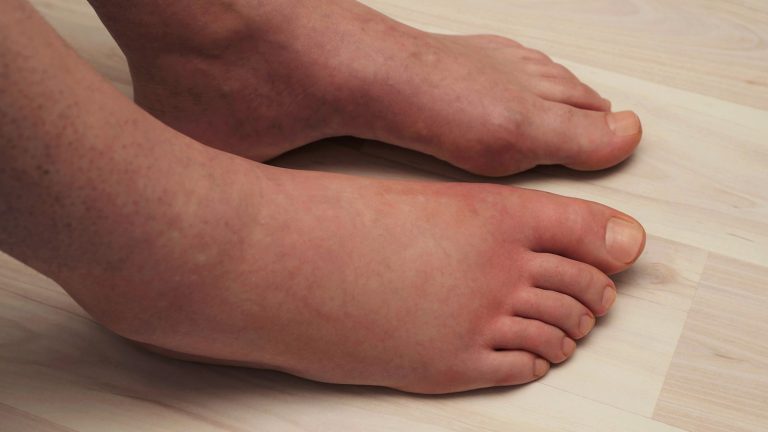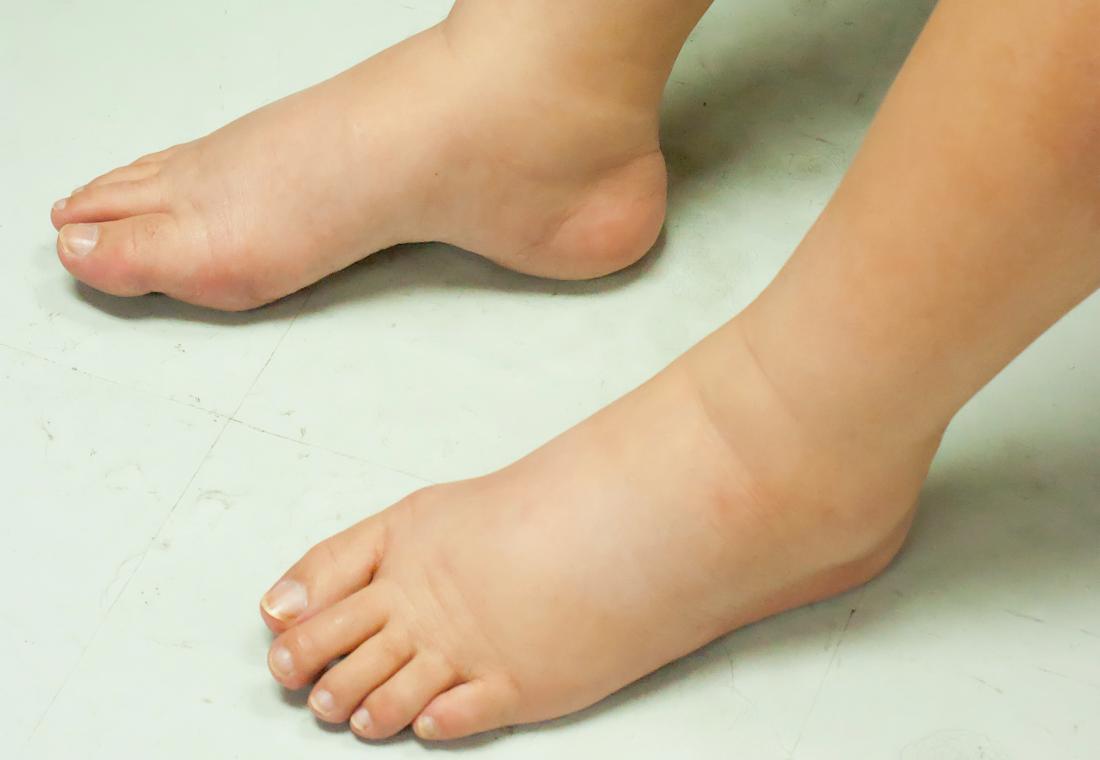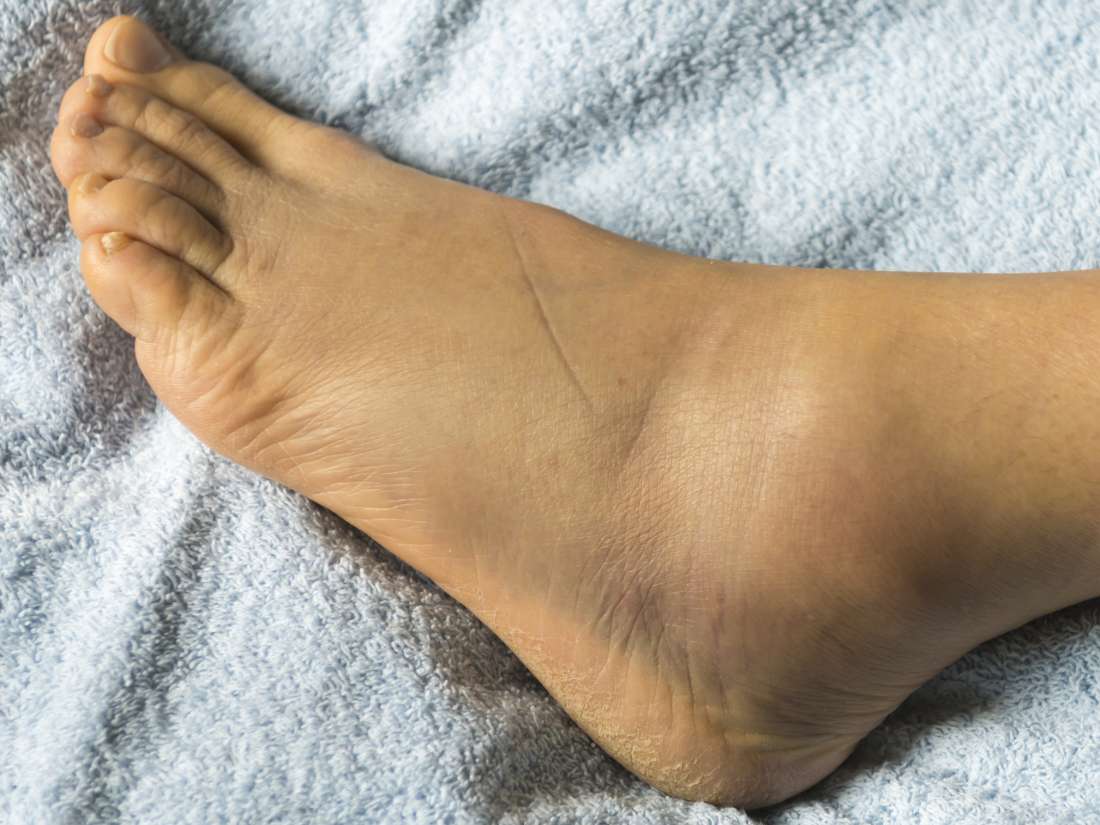Identifying the Reasons Behind Swollen Feet and Legs
Swollen feet and legs, also known as peripheral edema, can be a common occurrence for many people. Understanding the underlying causes of this condition is crucial to determining the appropriate treatment. In this section, we will explore some of the most common reasons why your feet and legs may be swollen.
Fluid retention is one of the most common causes of swelling in the feet and legs. This can occur as a result of standing or sitting for prolonged periods, which can cause fluid to accumulate in the lower extremities. Hormonal changes, such as those that occur during pregnancy, can also lead to fluid retention and swelling.
In addition to fluid retention, there are several medical conditions that can cause swelling in the feet and legs. These include heart failure, kidney disease, and liver disease. In heart failure, the heart is unable to pump blood efficiently, leading to a buildup of fluid in the body. Kidney disease can cause fluid and waste to accumulate in the body, while liver disease can lead to a condition called ascites, which is characterized by a buildup of fluid in the abdomen and legs.
Certain medications can also contribute to swelling in the feet and legs. These include blood pressure drugs, steroids, and antidepressants. In some cases, swelling may be a side effect of these medications, while in other cases, it may be a sign of an underlying medical condition.
In order to determine the underlying cause of swollen feet and legs, it is important to consult with a healthcare provider. They can perform a physical examination, take a medical history, and order diagnostic tests to help identify the cause of the swelling. Once the underlying cause has been identified, appropriate treatment can be initiated to help reduce the swelling and prevent further complications.
The Connection Between Swelling and Venous Insufficiency
Swelling in the feet and legs can often be a sign of venous insufficiency, a condition where the veins in the legs have difficulty returning blood to the heart. This can result in a buildup of fluid in the lower extremities, leading to swelling, discomfort, and other symptoms.
Venous insufficiency occurs when the valves in the veins that help to pump blood back to the heart become weakened or damaged. This can cause blood to pool in the veins, leading to swelling, varicose veins, and other symptoms. In some cases, venous insufficiency can be caused by deep vein thrombosis, a condition where blood clots form in the deep veins of the legs.
Symptoms of venous insufficiency can include swelling in the feet and ankles, aching or cramping in the legs, and the appearance of varicose veins. In some cases, the skin may also become discolored or ulcerated, leading to further complications.
If you are experiencing swelling in the feet and legs, it is important to consult with a healthcare provider to determine the underlying cause. They can perform a physical examination, take a medical history, and order diagnostic tests to help identify the cause of the swelling. If venous insufficiency is diagnosed, there are several treatment options available, including compression stockings, medication, and surgery.
Compression stockings are often recommended as a first-line treatment for venous insufficiency. These stockings help to improve circulation in the legs and reduce swelling by applying pressure to the veins. Medications, such as diuretics, may also be prescribed to help reduce swelling and fluid buildup in the legs.
In some cases, surgery may be necessary to treat venous insufficiency. This may include procedures to remove or repair damaged veins, or to remove blood clots from the deep veins of the legs. Your healthcare provider can help to determine the best course of treatment for your individual needs.
How Lifestyle Factors Contribute to Swollen Feet and Legs
In addition to medical conditions and medications, lifestyle factors can also contribute to swelling in the feet and legs. By making simple modifications to your daily routine, you can help to reduce swelling and improve your overall health and well-being.
Diet is an important factor to consider when it comes to swelling in the feet and legs. Consuming large amounts of salty or processed foods can contribute to fluid retention and swelling. To help reduce swelling, try to incorporate a variety of fresh fruits, vegetables, and whole grains into your diet. These foods are high in fiber and can help to promote healthy digestion and reduce fluid retention.
Exercise is another important factor to consider when it comes to reducing swelling in the feet and legs. Regular physical activity can help to improve circulation and reduce fluid buildup in the lower extremities. Try to incorporate a variety of low-impact exercises, such as walking, swimming, or cycling, into your daily routine. Aim for at least 30 minutes of moderate-intensity exercise most days of the week.
Alcohol consumption can also contribute to swelling in the feet and legs. Alcohol is a diuretic, which means that it can cause the body to lose fluid and electrolytes. This can lead to dehydration and fluid retention, which can contribute to swelling. To help reduce swelling, try to limit your alcohol consumption to moderate levels. This means no more than one drink per day for women and no more than two drinks per day for men.
In addition to these lifestyle modifications, there are several other tips that can help to reduce swelling in the feet and legs. These include elevating the legs, wearing compression stockings, and avoiding prolonged periods of standing or sitting. By incorporating these strategies into your daily routine, you can help to reduce swelling and improve your overall health and well-being.
Medical Conditions Associated with Swelling
Swelling in the feet and legs can be a sign of an underlying medical condition. In some cases, this swelling may be accompanied by other symptoms, such as shortness of breath, chest pain, or fatigue. If you are experiencing swelling in the feet and legs, it is important to seek medical attention to determine the underlying cause and receive appropriate treatment.
Heart failure is a common medical condition that can cause swelling in the feet and legs. This occurs when the heart is unable to pump blood efficiently, leading to a buildup of fluid in the body. Other symptoms of heart failure may include shortness of breath, fatigue, and irregular heartbeat.
Kidney disease can also cause swelling in the feet and legs. This occurs when the kidneys are unable to filter waste and excess fluid from the body. Other symptoms of kidney disease may include nausea, vomiting, and changes in urination.
Liver disease can also contribute to swelling in the feet and legs. This occurs when the liver is unable to produce enough protein to help keep fluid in the bloodstream. Other symptoms of liver disease may include jaundice, abdominal pain, and changes in appetite.
If you are experiencing swelling in the feet and legs, it is important to seek medical attention to determine the underlying cause. Your healthcare provider can perform a physical examination, take a medical history, and order diagnostic tests to help identify the cause of the swelling. Once the underlying cause has been identified, appropriate treatment can be initiated to help reduce the swelling and prevent further complications.
The Role of Medications in Causing Swelling
In some cases, medications can contribute to swelling in the feet and legs. This is known as medication-induced edema. While many medications can cause swelling as a side effect, some of the most common culprits include blood pressure drugs, steroids, and antidepressants.
Blood pressure drugs, also known as antihypertensive medications, are often used to treat high blood pressure. However, these medications can also cause fluid retention and swelling in the feet and legs. If you are taking blood pressure drugs and are experiencing swelling, talk to your healthcare provider about adjusting your medication or exploring alternative treatment options.
Steroids, which are often used to treat inflammation and autoimmune conditions, can also contribute to swelling in the feet and legs. This is because steroids can cause the body to retain sodium and water, leading to fluid buildup in the lower extremities. If you are taking steroids and are experiencing swelling, talk to your healthcare provider about adjusting your dosage or exploring alternative treatment options.
Antidepressants, which are used to treat depression and anxiety, can also cause swelling in the feet and legs. This is because antidepressants can affect the body’s balance of fluids and electrolytes, leading to fluid retention and swelling. If you are taking antidepressants and are experiencing swelling, talk to your healthcare provider about adjusting your medication or exploring alternative treatment options.
If you are experiencing swelling in the feet and legs as a result of medication, it is important to talk to your healthcare provider. They may be able to adjust your dosage, switch you to a different medication, or recommend alternative treatment options to help reduce swelling.
When to Seek Medical Attention for Swelling
While swelling in the feet and legs is often harmless and can be managed with home remedies, there are certain circumstances under which swelling warrants medical attention. If you are experiencing any of the following symptoms, it is important to seek medical attention as soon as possible:
- Severe or sudden swelling: If you experience sudden or severe swelling in the feet and legs, this could be a sign of a serious medical condition, such as a blood clot or heart failure. Seek medical attention immediately if you experience sudden or severe swelling.
- Swelling accompanied by pain or shortness of breath: If you are experiencing swelling in the feet and legs along with pain or shortness of breath, this could be a sign of a serious medical condition, such as a blood clot or heart failure. Seek medical attention immediately if you experience swelling accompanied by pain or shortness of breath.
- Swelling that does not improve with rest and elevation: If you have been resting and elevating your feet and legs, but the swelling does not improve, this could be a sign of a serious medical condition, such as a blood clot or heart failure. Seek medical attention if the swelling does not improve with rest and elevation.
If you are experiencing swelling in the feet and legs and are unsure whether it warrants medical attention, it is always best to err on the side of caution and seek medical attention. Your healthcare provider can perform a physical examination, take a medical history, and order diagnostic tests to help determine the underlying cause of the swelling and recommend appropriate treatment.
Home Remedies for Reducing Swelling
If you are experiencing swelling in the feet and legs, there are several home remedies that you can try to help reduce the swelling. These remedies are generally safe and effective, but it is important to consult with a healthcare provider if the swelling persists or worsens. Here are some tips for reducing swelling in the feet and legs:
- Elevate the legs: Elevating the legs above the level of the heart can help to reduce swelling by promoting the flow of blood and fluids back to the heart. Try to elevate your legs for at least 30 minutes, three to four times per day.
- Wear compression stockings: Compression stockings are designed to apply gentle pressure to the legs, which can help to reduce swelling and improve circulation. Talk to your healthcare provider about whether compression stockings are right for you, and be sure to follow their instructions for proper use.
- Avoid salty foods: Consuming large amounts of salty foods can contribute to fluid retention and swelling. Try to limit your intake of salty foods, and opt for fresh fruits, vegetables, and whole grains instead.
- Stay active: Regular physical activity can help to improve circulation and reduce swelling in the feet and legs. Try to incorporate at least 30 minutes of moderate-intensity exercise, such as walking or cycling, into your daily routine.
- Stay hydrated: Drinking plenty of water can help to flush out excess fluids and reduce swelling in the feet and legs. Aim to drink at least eight glasses of water per day, and avoid alcohol and caffeine, which can contribute to dehydration.
By incorporating these home remedies into your daily routine, you can help to reduce swelling in the feet and legs and promote overall health and well-being. However, it is important to consult with a healthcare provider if the swelling persists or worsens, as this could be a sign of a more serious medical condition.
Preventing Swelling in the Feet and Legs
Swelling in the feet and legs can be uncomfortable and unsightly, but there are several steps you can take to prevent it from occurring. By incorporating these strategies into your daily routine, you can promote overall health and well-being and reduce the risk of swelling in the feet and legs:
- Maintain a healthy weight: Being overweight or obese can put extra pressure on the veins in the legs, making it more difficult for blood to flow back to the heart. By maintaining a healthy weight, you can reduce the risk of swelling in the feet and legs.
- Stay active: Regular physical activity can help to improve circulation and reduce the risk of swelling in the feet and legs. Aim to incorporate at least 30 minutes of moderate-intensity exercise, such as walking or cycling, into your daily routine.
- Avoid prolonged periods of standing or sitting: Standing or sitting for long periods of time can contribute to swelling in the feet and legs. Try to take regular breaks and move around every 30 minutes to promote circulation.
- Elevate the legs: Elevating the legs above the level of the heart can help to promote the flow of blood and fluids back to the heart, reducing the risk of swelling in the feet and legs.
- Wear comfortable shoes: High heels and tight shoes can contribute to swelling in the feet and legs. Opt for comfortable, supportive shoes that fit well and provide adequate cushioning.
- Limit alcohol consumption: Alcohol can contribute to fluid retention and swelling in the feet and legs. Try to limit your alcohol intake, and opt for water or other non-alcoholic beverages instead.
By incorporating these strategies into your daily routine, you can help to prevent swelling in the feet and legs and promote overall health and well-being. However, if you are experiencing persistent or severe swelling, it is important to consult with a healthcare provider to determine the underlying cause and receive appropriate treatment.







